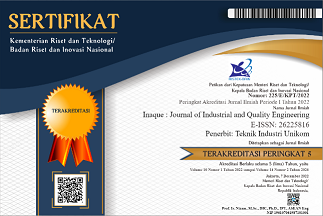PENGELOMPOKAN PERSEDIAAN SPARE PARTS DENGAN METODE CLASS BASED STORAGE KLASIFIKASI FSN BERDASARKAN TURNOVER RATIO (TOR)
DOI:
https://doi.org/10.34010/iqe.v13i1.15360Abstract
Effective spare parts management at PT XYZ requires accurate classification based on their turnover rate. This research aims to categorize spare parts into fast-moving, slow-moving, and non-moving categories to improve inventory management efficiency and support the company's operational sustainability. From the analysis of 130 types of spare parts, it was found that 69 (53%) fell into the fast-moving category, 50 (38.5%) were slow-moving, and 11 (8.5%) were non-moving. This classification is critical because it allows the company to determine the optimal order quantity and storage location for each category of spare parts. Thus, the company can prevent stock shortages on frequently used parts, which can disrupt smooth operations. In addition, activities with the grouping of goods can increase the accuracy of the stock-taking process, making it easier to make decisions related to inventory management. The data in this study were collected through various methods, including direct observation, literature study, and analysis of company historical data. The results show that classifying spare parts based on turnover ratios can be a solid basis for more effective inventory management policies. The application of this classification, PT XYZ is expected to improve operational efficiency and optimize the use of existing resources, to contribute to the growth and desire of the company in the future.
Keywords: Class-based storage method; FSN Classification; Inventory Control; Spare Parts; Turnover Ratio
Downloads
Published
Issue
Section
License
Copyright (c) 2025 Dinda Elyana Agustin

This work is licensed under a Creative Commons Attribution-ShareAlike 4.0 International License.
Authors who publish this journal agree to the following terms:
The author holds the copyright and grants the right of the first publication journal to enable INAQUE to share the work with acknowledgment of the author's work and early publications in this journal.
Authors may include separate additional contractual arrangements for the non-exclusive distribution of the journal's published version (for example, submit to an institutional repository or publish in a book), with the acknowledgment of its initial publication in this journal
Authors are permitted and encouraged to post their work online before and during the delivery process, as it may lead to productive exchanges, as well as quotations of previously published and longer works








